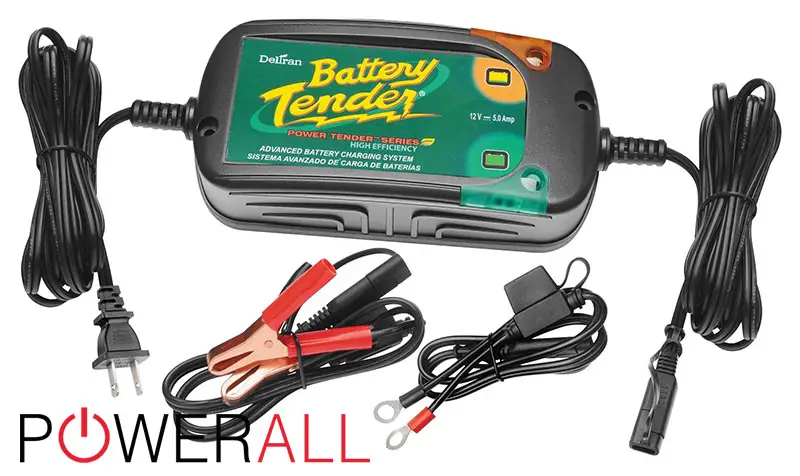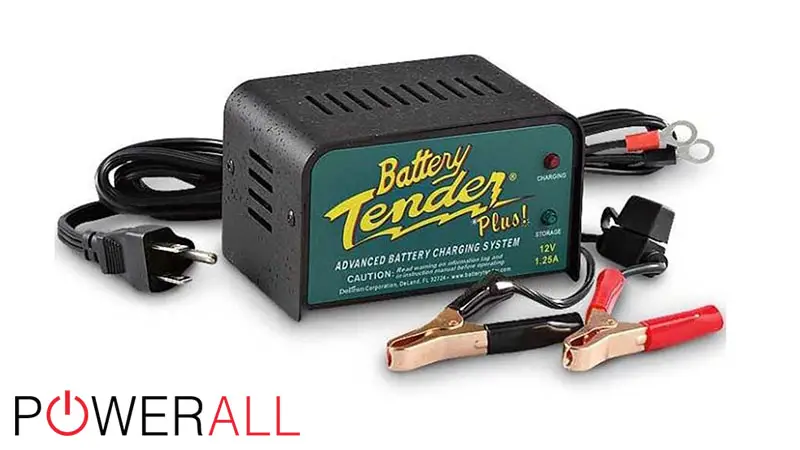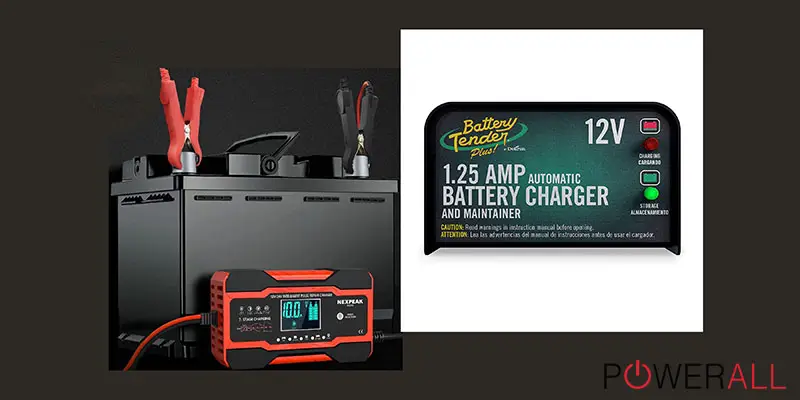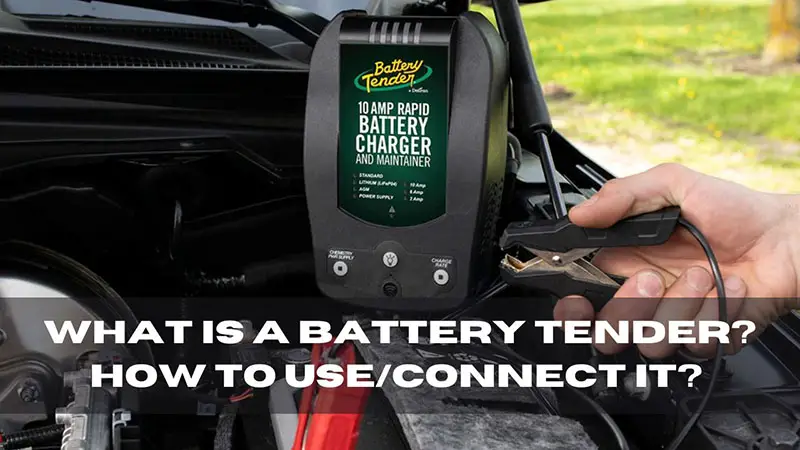No motorbikes or cars can run well without power-maintaining devices. High-performance batteries are recommended, sure – but they are far from enough to ensure your automobiles always sustain their maximum operation. What to do, then?
Rumors have it that add-on accessories like Battery Tenders are every cyclist’s lifesaver. Nevertheless, many novices are still unsure of their functions and even mistake these products for battery charger models.
This article aims to clear lingering confusion for you, explaining in detail the definition of a Battery Tender and what it does.
Battery Tender: What Is It & How Does It Work?

1. What Is It?
Battery Tenders is a brand of battery maintainers, which are small devices that send energy trickles to the lead-acid battery at constant rates and in separate intervals – just the bare minimum required to foster its operation, no more, no less.
This mechanism lets your batteries sit for extended periods without power waste and retain full charges quickly. Not to mention, by keeping overcharging issues at bay, these devices allow your batteries to last much longer than they are supposed to!
How to connect Battery Tenders varies across popular models and brands. Some battery manufacturers ask you to plug them into auxiliary power outlets, while others recommend pairing the tenders with small-sized solar panels. Regardless, consult the brand/manual carefully before plunging in.
2. How Does it Work?
Now that you understand what they are, it’s easy to envision their working rules.
Basically, Battery Tenders are quite similar to regular chargers (there are still differences between them, though, which we will return to later). Yet, the energy quantities sent to your batteries over time by these tenders are extremely small, keeping the bike at optimal charges.
For better visualization, you can compare their systems to a couple of cables hooked to a battery terminal – except that Battery Tenders are far smarter. Manufacturers program them to read the battery capacity/current power levels and how much is needed to keep them at their peak.
Note that these tenders will not do anything if your batteries are not at specifically low-charge levels. They simply wait until the bike’s battery stoops EXTREMELY low before sending out minimum extra electric power. That way, there will never be any overcharging risks, and your bike is always maintained properly.
How to Use Them Right?

1. Take every necessary precaution step before you start:
- Wear body and eye protection gears
- Ensure immediate access to water and soap (in case the battery acids contact your skin)
- Have someone nearby so that help is available when necessary
- Check that the working place is well-ventilated.
2. Put the tender far from the batteries (within the cable’s lengths).
3. Switch the device to “Off” (the AC input plug and electrical outlet should not be connected yet). Then place the DC and AC cords of these tenders away from the vehicle’s moving parts (ex: pulleys, fan blades, hoods, doors, etc.).
4. Identify the Negative (N, NEG, -) and Positive (P, POS, +) battery posts. Assess which one is connected or grounded to the bike’s chassis. After that, click the tender clips depending on how the battery power connections are arranged:
Negative-grounded bikes:
- Link the Red/Positive clip to your Positive (P, + POS) ungrounded post.
- Rasp the Black/Negative clip to the engine block or vehicle chassis (preferably the heavy metal parts) far from the batteries.
- Do not touch the carburetor or fuel lines.
Positive-grounded bikes:
- Link the Black/Negative clip to your Negative (N, -, NEG) undergrounded post.
- Rasp the Red/Positive clip to the engine block or vehicle chassis far from the batteries.
5. Should nothing go wrong, you may switch the tender on while it’s plugged in, and the deep-cycle batteries will charge. The red light on tells you the battery is charging.
Note down the following points:
- The tender will not start automatically if your output voltage does not exceed 3V. At least 3V is required for the device to work.
- Does your 12-volt battery (neither supplying constant currents nor being charged) produce an output of less than 9V? Immediate replacements are your best bet; these batteries likely suffer from defective materials.
Battery Tender vs. Maintenance Charger: Which One to Choose?

1. Overheat Protections: Battery Tender Wins
Tenders are wonderful in keeping overheating issues at bay. They monitor the battery temperatures closely and shut down the entire charging procedure if it becomes too hot.
Meanwhile, trickle chargers have no such features; riders may leave them plugged in for 10-12 hours or even days.
2. Automatic Shut-Offs: Battery Tender Wins
These shutoff functions are integral in every tender: whenever the acid batteries are 100% charged, they will shut down immediately to avoid overheating/overcharging.
Regular chargers also have these features – but only in automatic battery charger models. The manual versions cannot meet your expectation in this regard.
3. Safety: Battery Tender Strikes Again
Unlike motorcycle battery chargers, tenders employ desulfation pulses to clean the battery plates. Hence, no buildups of acid battery sulfation can occur, and there’s no need to worry about premature failure. These devices win big time against their charger rivals.
4. Speed: Charger Outperforms
It’s hard to produce a specific number since both types are available in numerous models.
Nevertheless, it’s safe to say chargers earn their first point here, varying the energy flow to charge the dead battery pack more quickly. On the other hand, tenders send tiny trickles over longer periods of time to prevent overcharges, meaning they are much slower.
Final Verdict
Automotive Battery Tenders are the go-to option, outperforming board battery chargers in almost every critical aspect. The float chargers might be better in terms of speed – but between fast charging pace and improved battery life expectancy, you know which one to choose, don’t you?
FAQs
1. Is It Ok To Leave The Battery Tender On All The Time (Or In All Winter)? How Long Should I Leave?
Yes. Leave it there as many hours as you want. The tenders will monitor the process and shut off automatically if needed; you don’t even have to worry about consequential damages.
2. When Should You Use The Battery Tender?
- You are not a daily rider
- You are about to store the bike for a long time (like winter)
3. Is A Battery Tender The Same As A Charger?
Yes, it’s a smart version of the trickle charger (it knows when to charge).
4. Can A Battery Tender Ruin Your Battery?
No. It even protects the battery.
5. Can I Start My Bike While It Is Connected to The Battery Tender?
Yes, you can. No extreme damage to cells, battery voltages or charger output currents has been detected so far!
Conclusion
We hope our readers have grasped a full understanding of how board Battery Tenders work.
A further breakdown of their performances against amp chargers is also provided to give you a more objective overview. Of course, we have given our opinions, but the ultimate choice is still yours in the end!
Remember their pros, cons, and usage guides to enjoy a smooth riding experience – especially for larger vehicles. Answers to other popular questions are also addressed in the FAQ section.









0 Comments